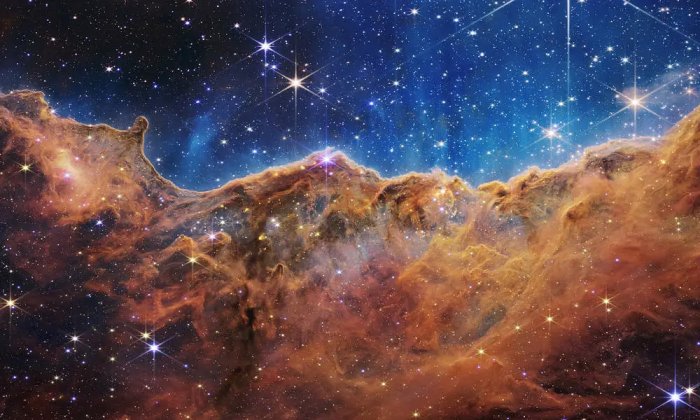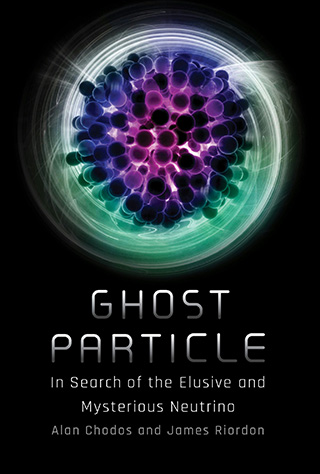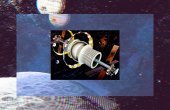Are Neutrinos the Key to Communicating With Aliens?

Neutrinos. They’re tiny, just points in space. Each one barely affects anything else. They pass through you, the Earth, and the sun with hardly a trace. They almost never reveal themselves, but without them we couldn’t know why the stars shine. Each has a minute mass. And while their individual interactions are meager, there are so many that, all together, they might change the courses of galaxies. They are the most mysterious known particles in the universe.

They were even more mysterious in the years immediately following their initial discovery in the 1930s. That may in part explain one of the first attempts to apply them to at least one dubious technological application: telepathic communication. In the mid-1960s, according to a report commissioned by the U.S. Defense Intelligence Agency, Soviet paranormal researcher Ye. Parnov proposed a theory that relied on neutrinos as carriers in what he called a telepathic field. Parnov postulated that the field linked all humans together, allowing us to communicate directly from mind to mind and to see the future.
Parnov’s neutrino telepathy theory was just one of several projects that were the subjects of Soviet and Czechoslovakian paranormal research at the time. To put it in perspective, other notable efforts in the paranormal science community behind the Iron Curtain included a form of instantaneous communication based on murdering bunnies in a submarine at sea, methods to telepathically attack personnel in U.S. and allied nuclear missile silos, and devices known as psychotronic generators that were supposedly capable of such impressive feats as putting snails to sleep and killing flies at very short range. Neither the neutrino telepathy theory nor any other of these projects has gained any traction in the last half century.
As bizarre as neutrino-based telepathy might sound, neutrinos do hold real potential for fascinating and exotic applications. In fact, some scientists have even suggested that they could play a role in detecting or communicating with extraterrestrial civilizations.
The Search for Aliens in Space
Intelligent life should be common in the universe, at least according to people who take to heart some versions of an equation that astronomer and astrophysicist Frank Drake proposed in 1961. Drake’s equation combines things we know well about the universe (the rate of star formation) with things we are learning more about (the fraction of stars that have habitable planets near them) and things we know very little about at all (the likelihood that life will develop on a habitable planet, and the time it typically takes for intelligent life to evolve, produce detectable signs of their existence, and send signals into space). Most of the best guesses that go into the equation imply there is almost certainly intelligent life out there somewhere.
If Drake’s equation is correct, the universe should be teeming with intelligent life. And if that’s true, we should have seen evidence by now.
Drake’s equation has been the subject of discussions, arguments, refinements, and proposed corrections over the decades. Perhaps the greatest challenge the equation has faced is a simple question Enrico Fermi posed: “Where is everyone?” If Drake’s equation is correct, the universe should be teeming with intelligent life. And if that’s true, we should have seen evidence by now.
It’s a big question, and covers a complex array of factors, including those in Drake’s equation and more. One open issue is just how a distant alien might choose to send us a message, if they were so inclined. At first glance, a simple electromagnetic signal, in the form of radio, visible light, X-ray, or gamma ray photons might come to mind. Unfortunately, while the space between stars and galaxies has much less material in it than we are used to in our atmosphere on Earth, space is a great deal murkier than you might imagine. In the course of its travels from a distant planet a beam of photons will encounter dust and plasma that would likely distort and obscure signals.
Another possibility that some researchers have proposed is communication via gravitational waves. Since 2016, we’ve had the ability to measure gravitational waves, thanks to the groundbreaking advancements of the Laser Interferometer Gravitational Wave Observatory (LIGO), a pair of enormous installations located in Hanford, Washington, and Livingston, Louisiana. Each LIGO lab consists of an L-shaped arrangement of laser beams that bounce back and forth through four-kilometer-long tunnels in order to measure ripples in space. These ripples indicate the passing of gravitational waves. So far, LIGO has been able to detect waves caused by the collision of black holes and neutron stars billions of light years away.
Theoretically, an advanced alien could send a message encoded in gravitational waves. The waves would pass easily through the intervening, dust-filled space and we could observe them with LIGO or, more likely, a much more sensitive, subsequent-generation gravitational wave observatory. To produce signals we could measure, the alien would need to generate them with transmitters built of black holes or other super massive components — a difficult but perhaps not impossible task for a sufficiently advanced alien.
Neutrinos provide an alternative for communicating over galactic and cosmic distances that combines some of the benefits and challenges of both photons and gravitational waves. Like gravitational waves, they can propagate over enormous distances without being significantly scattered or absorbed by interstellar dust or, for that matter, asteroids, planets, or even stars. Like photons of light and other electromagnetic radiation, aliens could produce neutrinos in beams that they can aim at promising regions of space where a message might be most likely to be received. This sort of targeting is much more efficient than broadcasting widely, if you have some idea of where to point it.
“I think it’s not crazy that some very advanced civilization would use neutrino beams to communicate,” says Anthony Zee of the Kavli Institute for Theoretical Physics in Santa Barbara, California. “It has obvious advantages. It travels at nearly the speed of light, it’s not attenuated, it goes through everything. I personally think that instead of spending zillions and zillions on these huge antennas” that are the primary tools in searching for signs of extraterrestrial intelligence, “these guys should fund some neutrino detectors. It wouldn’t even have to be a big detector; it could just collect data and see if you hear anything.”
As is true for light and gravitational waves, neutrinos travel at finite speeds, which means that anyone using them to send a directed signal will have to think ahead a bit.
As is true for light and gravitational waves, neutrinos travel at finite speeds, which means that anyone using them to send a directed signal will have to think ahead a bit. If the star system you’re messaging is a million light years away, then you’ll have to point your neutrino beam to the spot where your target will be in a million years, because neutrinos travel at speeds comparable to the speed of light. Based on the distribution of potentially habitable planets, even inside a single galaxy, two-way communication will suffer some serious delays.
Among the primary arguments against aliens using neutrinos to communicate — even if you assume they have the technology do it — is that, all in all, it’s simply much easier and cheaper (in terms of the energy involved) to send signals with photons than with neutrinos or gravitational waves. A large percentage of photons will be scattered or absorbed, but an alien could always compensate by turning up the power in their transmitters, with a lot less effort than creating neutrino beams.
One way to turn photon signal power way up, according to Zee and neutrino experimentalist John Learned, might still rely on neutrinos. In a paper titled “The Cepheid Galactic Internet,” they describe a system that could theoretically change the blinking of Cepheid variable stars that have naturally fluctuating light outputs.
“It turns out the reason they’re blinking is they’re on the verge of instability,” says Zee, which means that a small nudge could modify the variation in a Cepheid star’s fluctuations. “The idea is to shoot a neutrino beam off center into the star and trigger some sort of instability.” It’s the particle physics equivalent to using the noise from a gunshot to start an avalanche on an unstable snowfield. “We call it tickling the star, tickling the Cepheid variable,” says Zee. “The simple idea is that an advanced civilization would be able to capture the output of the star and somehow store it and dump it into a neutrino beam as a pulse . . . you can do some estimates, and it’s not completely crazy. If a planet orbiting a star could collect even one percent of the energy output per unit time, you can of course multiply that by storing it . . . and then pulse it back into the star.” According to Zee, “It would act like a universal beacon.”
“We propose that these (and other regularly variable types of stars) be searched for signs of phase modulation (in the regime of short pulse duration) and patterns, which could be indicative of intentional signaling,” the physicists write in their paper’s abstract, on the chance that some distant intelligence is already uploading information to the Cepheid Galactic Internet. They conclude the paper by writing, “It may be a long shot, but should it be correct, the payoff would be immeasurable for humanity. The beauty of this suggestion seems to be simply that the data already exists, and we need only look at the data in a new way.”
Catching Cosmic Engineers at Work
Even if aliens don’t choose to communicate via neutrinos or neutrino-modulated stars, the particles could still reveal their presence in the universe as a side effect of alien activities. It seems reasonable to guess that intelligent life, wherever it is, would have a similar thirst for knowledge that humans have. It’s conceivable that advanced aliens might rely on particle accelerators to conduct research, as physicists around our world currently do.
We already know that accelerators powerful enough to explore the ultimate limits of nature, at a tiny scale called the Planck limit, would require accelerators far too big to fit on a planet. The smaller the scale you want to study with an accelerator, the higher the energy you need to accelerate particles, and the larger the accelerator must be.
In a paper published on the ArXiv in 2015, Brian Lacki, then at the Institute for Advanced Study in Princeton, New Jersey, estimates that an accelerator that could explore nature at the Planck limit would be as large as a typical solar system. If we could find hints of one running, it would be a clear sign of super intelligent beings, which Lacki terms “cosmic engineers,” somewhere in the universe. High-energy neutrinos could provide that sign.
Smashing together matter, whether in a terrestrial accelerator or in one built by cosmic engineers, creates enormous showers of particles. By studying the showers, scientists can gain insights into the structure of subatomic particles, recreate conditions in the early universe, and search for new particles that may supply clues to science beyond the models we now know about.
In a Planck accelerator, the showers would include neutrinos with energies far greater than those that could be produced in even the most violent astronomical events, potentially providing a beacon of the sentience responsible for creating the accelerator. The highest-energy neutrinos so far detected on Earth reach thousands of trillions of electron volts, while those from a Planck accelerator would be a billion times more energetic still.
Any beings capable of building a Planck accelerator could probably find a way to capture even neutrinos if they wanted, rather than broadcasting to the universe that their experiments were underway. Keeping the high-energy neutrinos under wraps would be tricky. One way to do it would be to pile up something dense, like lead, at the end of the accelerator to catch the beam before the neutrinos sail into space. It would have to be a big piece of lead to do it, probably about as large as the accelerator itself. The downside to catching the beam is that it would deprive alien researchers of potentially interesting science that could result from the super-high-energy neutrinos crashing into other matter in the universe. They would have to be pretty committed to staying invisible to try to keep the neutrinos out of sight.
It’s also unlikely that aliens would keep such an accelerator running beyond the time it took to gather data from an experiment. On Earth, we mothball and decommission experiments once they’ve supplied all the results we can hope for. It’s hard to imagine what goes through an alien’s mind, but it seems likely they would do the same. Once their experiments are completed, they would probably turn them off and go in search of other things to study. If that’s so, neutrinos coming from solar system-sized accelerators would be fleeting, as alien beings around the universe built them, ran experiments, and shut them down.
Still, if we were to discover such high-energy neutrinos, they would suggest either that there are advanced accelerator scientists at work somewhere in the universe or that there are some exciting natural things going on in the cosmos that are beyond the physics we currently understand. Either way, there’s a case to be made to design detectors on our planet to look for the ultra-high-energy particles.
Discovering high-energy neutrinos could mean advanced alien technology at work or reveal cosmic phenomena beyond our current understanding of physics.
Neutrinos could also reveal alien-engineered structures known as Dyson spheres. Visionary physicist Freeman Dyson proposed that as civilizations advance, their need for energy would increase beyond the relatively meager proportion of energy coming from a star that falls on a planet comparable to Earth. Most of the energy from our sun streams out into space. One solution, Dyson suggested, could be to enclose a star in a sphere that collects all the available energy a star produces.
Although a Dyson sphere would prevent us from seeing the light and much of the rest of the radiation coming directly from the star inside, that doesn’t render the sphere itself invisible, at least in the simplest implementation of such a structure. The waste heat that’s left over after the residents of the sphere have extracted useful energy from their entrapped star has to go somewhere. It would warm the outer sphere, which in turn would glow as a result of the radiation that is emitted from any warm object (this is why we humans turn up clearly in infrared images). If the inhabitants of a system inside a Dyson sphere prefer to keep a low profile, they could pipe the heat away from the bulk of the sphere and send it in a direction where they’re fairly certain there is no one to observe it.
Neutrinos, however, would give them away. Even a Dyson sphere with a wall thickness comparable to the radius of our solar system would trap only a tiny fraction of the neutrinos coming from a star like our sun. If an alien tried to build such a thing from material comparable in density to the earth, the total mass would be a trillion times that of the sun, in which case it would collapse under its own gravity and become a black hole, crushing everything inside it. Dyson spheres generally are fanciful ideas and would be hard to build at all, while making one big enough to ensure that neutrinos don’t reveal the star inside is simply impossible.
We don’t have neutrino telescopes capable of seeing an individual Dyson sphere at any great distance, but if one were to try to surreptitiously glide past our solar system, the neutrino flux would potentially turn up even in existing detectors like Super-Kamiokande. Of course, the gravitational interaction would throw our solar system into disarray as well, but that’s a topic for another time.
Let’s be real: The odds are slim that we will communicate with aliens via neutrino beams. Neutrino-based technology, however, may ultimately be the best — and in some cases, the only — way to manage such feats. For now, it’s probably more the stuff of science fiction. Bear in mind, though, the same could once have been said of airplanes, lasers, travel to the moon, and Wolfgang Pauli’s “desperate” 1930 hypothesis of the neutrino — a particle he proposed, not knowing it would later revolutionize our understanding of the universe.
Alan Chodos is a Research Professor of Physics at the University of Texas at Arlington, a former Director of the Yale Center for Theoretical Physics, and the former Associate Executive Officer of the American Physical Society, where he is a Fellow.
James Riordon is a science journalist who has written for Science News, Scientific American, New Scientist, Popular Science, Washington Post, Science, Ad Astra, Physics Today, and Analytical Chemistry. He is a past President of the DC Science Writers Association and Cofounder of the Southwest Science Writers Association. He is the author of the forthcoming (November 2025) book “Crush: Close Encounters With Gravity.”
Chodos and Riordon are the coauthors of “Ghost Particle: In Search of the Elusive and Mysterious Neutrino,” from which this article is excerpted.



